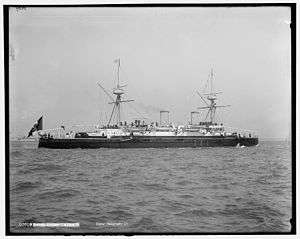Italian cruiser Vesuvio
 | |
| History | |
|---|---|
| Name: | Vesuvio |
| Namesake: | Mount Vesuvius |
| Builder: | Cantiere navale fratelli Orlando, Livorno |
| Laid down: | 10 July 1883 |
| Launched: | 21 March 1886 |
| Commissioned: | 16 March 1888 |
| Struck: | 11 May 1911 |
| Fate: | Sold for scrap, 1915 |
| General characteristics | |
| Type: | Protected cruiser |
| Displacement: | 3,373 long tons (3,427 t) |
| Length: | 283 ft 6 in (86.4 m) |
| Beam: | 42 ft 6 in (13.0 m) |
| Draft: | 19 ft (5.8 m) |
| Installed power: | |
| Propulsion: | 2 shafts, 2 horizontal compound steam engines |
| Speed: | 17 knots (31 km/h; 20 mph) |
| Range: | 5,000 nmi (9,300 km; 5,800 mi) at 10 knots (19 km/h; 12 mph) |
| Complement: | 12 officers and 296 men |
| Armament: |
|
| Armor: |
|
Vesuvio was a protected cruiser of the Italian Regia Marina (Royal Navy) built in the 1880s. She was the third member of the Etna class, which included three sister ships. Named for the volcano Mount Vesuvius, the ship's keel was laid down in July 1883. She was launched in March 1886 and was commissioned into the fleet in March 1888. She was armed with a main battery of two 10-inch (254 mm) and six 6-inch (152 mm) guns, and could steam at a speed of around 17 knots (31 km/h; 20 mph). Her career was relatively uneventful; the only significant action in which she took part was the campaign against the Boxer Rebellion in China in 1900. She was stricken from the naval register in May 1911 and sold for scrap in 1915.
Design
Vesuvio was 283 feet 6 inches (86.4 m) between perpendiculars, with a beam of 42 feet 6 inches (13.0 m). She had a mean draft of 19 feet (5.8 m) and displaced 3,373 long tons (3,427 t). Her crew numbered 12 officers and 296 men. The ship had two horizontal compound steam engines, each driving a single propeller, with steam provided by four double-ended cylindrical boilers. Vesuvio was credited with a top speed of 17 knots (31 km/h; 20 mph) from 6,820 indicated horsepower (5,090 kW). She had a cruising radius of 5,000 nautical miles (9,300 km; 5,800 mi) at a speed of 10 knots (19 km/h; 12 mph).[1]
The main armament of the ships consisted of two Armstrong 10-inch (254 mm), 30-caliber breech-loading guns mounted in barbettes fore and aft. She was also equipped with six 6-inch (152 mm), 32-caliber, breech-loading guns that were carried in sponsons along the sides of the ship. For anti-torpedo boat defense, Vesuvio was fitted with five 57-millimeter (2.2 in) 6-pounder Hotchkiss guns and five 37-millimeter (1.5 in) 1-pounder Hotchkiss guns. Vesuvio was also armed with four 14-inch (356 mm) torpedo tubes. One was mounted in the bow underwater and the other three were above water.[1] She was protected with an armored deck below the waterline with a maximum thickness of 1.5 inches (38 mm). The conning tower had .5 in (13 mm) worth of armor plating.[2]
Service history
Vesuvio was built by the Livorno shipyard, with her keel being laid down on 10 July 1883. Her completed hull was launched on 21 March 1886, and after fitting-out work was finished, she was commissioned into the Italian fleet on 16 March 1888.[2] Vesuvio and her sisters Stromboli and Ettore Fieramosca participated in the 1893 naval maneuvers as part of the Squadron of Maneuvers, which was tasked with defending against the Permanent Squadron.[3] Vesuvio was placed in reserve for 1896, though she was reactivated to take part on the naval maneuvers at the end of the year.[4] During these maneuvers, she was assigned to a force tasked with defending against a simulated French fleet.[5]
In 1900, she and Ettore Fieramosca were sent to Chinese waters to assist in the suppression of the Boxer Rebellion as part of the Eight-Nation Alliance.[1] Both ships were formally assigned to the Cruising Squadron in Chinese waters in 1901.[6] During 1901, she made stops in Shanghai, Wusong, and Hong Kong.[7] After a second deployment to the Far East from 1906 to 1909, Vesuvio was placed in reserve, struck from the Navy List on 11 May 1911 and sold for scrap in 1915.[8][2]
Notes
References
- Akers, T. H. (1902). The Log of the Commission of H.M.S. Astraea On the Mediterranean and China Stations. London: Westminster Press. OCLC 680860616.
- Brook, Peter (2003). "Armstrongs and the Italian Navy". In Preston, Antony. Warship 2002–2003. London: Conway Maritime Press. pp. 94–115. ISBN 0-85177-926-3.
- Clarke, George S. & Thursfield, James R. (1897). The Navy and the Nation, or Naval Warfare and Imperial Defence. London: John Murray. OCLC 3462308.
- Gardiner, Robert, ed. (1979). Conway's All the World's Fighting Ships: 1860–1905. London: Conway Maritime Press. ISBN 0-85177-133-5.
- Lansdale, P. V., Lieut. (1894). Notes on the Year's Naval Progress. Information from abroad: General information series. XIII (July 1894 ed.). Washington, D. C.: Government Printing Office. pp. 354–73. OCLC 145338985.
- "Naval Notes–Italy". Journal of the Royal United Service Institution. London: J. J. Keliher. XLV (283): 1136. September 1901. doi:10.1080/03071840109418900. OCLC 8007941.
- Robinson, Charles, ed. (March 1897). "The Fleets of the Powers in the Mediterranean". Navy and Army Illustrated. London: Hudson & Kearns. III: 186–187. OCLC 7489254.